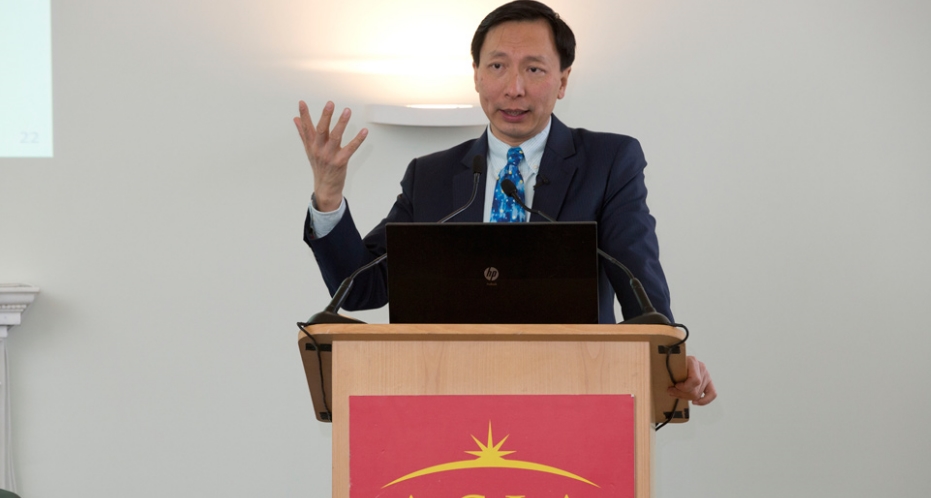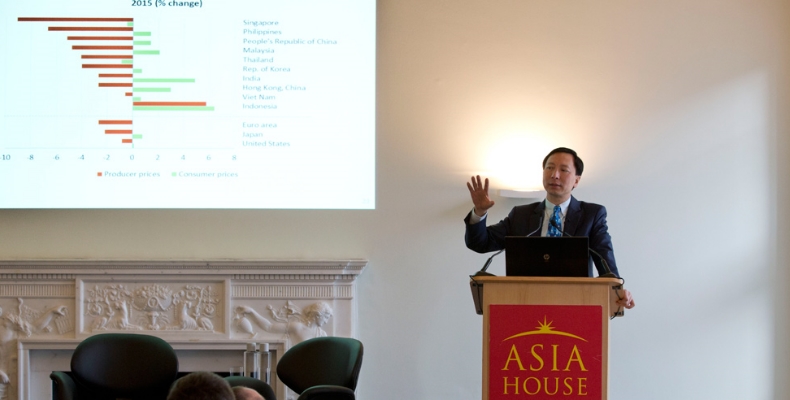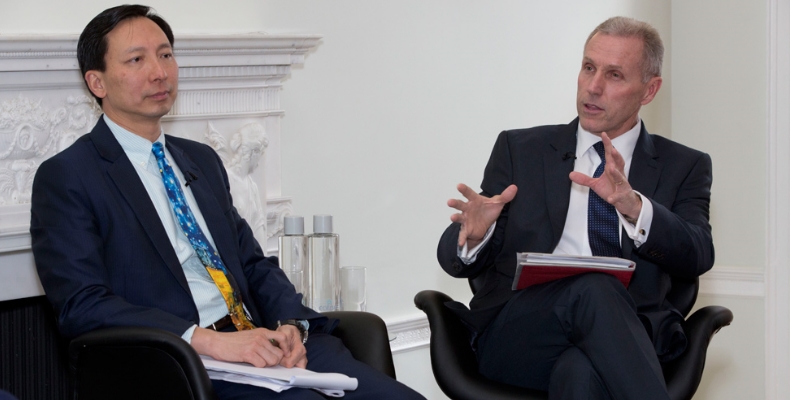Driving commercial and political engagement between Asia, the Middle East and Europe
Driving commercial and political engagement between Asia, the Middle East and Europe
Driving commercial and political engagement between Asia, the Middle East and Europe

Growth in many developing countries in Asia has slowed down in the past year and is forecast to continue on a downward trajectory for the next two years, according to the Asian Development Bank, partly owing to China’s continual economic deceleration. But the slowdown has been offset by the Indian economy which continues to see robust growth and remains the fastest growing large economy in the world.
Some low-wage Asian economies are benefiting from China’s retreat from manufacturing which has helped arrest the region’s economic deceleration.
These were some of the comments made by Shang-Jin Wei, Chief Economist at the Asian Development Bank (ADB), speaking at the UK launch of the ADB’s flagship economic publication Asian Development Outlook (ADO) 2016, a forecast of growth prospects across developing Asia, at Asia House on Tuesday.
Growth in developing Asia has softened and is forecast to be 5.7 per cent in both 2016 and 2017, compared to 5.9 per cent last year, Mr Wei said in his speech to business leaders, diplomats, academics and consultants.
From 2011 onwards growth in the developing countries in Asia has consistently slowed down.
China’s growth is forecast to slow down to 6.5 per cent in 2016 and to slow even further to 6.3 per cent in 2017 – a drop from 2014 when China’s growth was 7.3 per cent.
The Indian economy, however, is still growing fast and is now the fastest growing large economy in the world, supported by public and private investment, with growth projected at 7.4 per cent in 2016 and 7.8 per cent in 2017.
However, reforms to raise labour productivity could invigorate developing Asia’s ‘potential growth,’ Mr Wei said. ‘Asia’s potential growth’ is the theme of ADO 2016.
Mr Wei put China’s slowdown down to a shrinking working-age population in China, as well as rising wages. “A progressively lower growth rate in China is to be expected as it is driven by structural or fundamental factors,” Mr Wei said.

Chief Economist at the Asian Development Bank Shang-Jin Wei launched Asian Development Outlook 2016 at Asia House. Image credit: George Torode
“Countries always slow down in growth as wages go up,” he said. “There are fewer people working in China this year than last year and the following year there will be fewer people again. The working age population of China is shrinking by three to five per cent each year. Falling productivity in China is leading to lower GDP growth,” he added.
He said that China had relaxed its one-child policy in 2013 owing to growth rate concerns, but he said there would be no immediate positive impact. “Growth rates will get worse and the dependant ratio will get worse in the short-term. In the next two decades the total number of working people in China will be unchanged and there will be more dependants,” he said.
“Moderating growth in the People’s Republic of China is spilling over to other economies. A sharper fall is unlikely, but if it happens, it could generate a bigger impact,” he added.
Mr Wei said that whilst consumer price inflation (CPI) remained subdued, so was not a big worry, many economies in developing Asia faced possibly harmful producer price index (PPI) deflation.
He said: “The slow recovery in global commodity prices will keep CPI inflation low but many Asian economies are experiencing producer price index deflation. Foreign producer prices mean the real value of company debt can rise over time and you can find yourself in financial difficulties. In the post-war era per capita real GDP growth is visibly lower during PPI deflations than during CPI deflations,” he said. “This deserves more attention from policy-makers.”
However, it is not all doom and gloom. As China shifts towards a services and consumption-driven economy, some Asian countries, particularly those in Southeast Asia that have lower wages, are well-placed to take over its manufacturing sector and increase their market share, he said.
“In the face of China’s slowdown, some countries could grow faster as a result of changes taking place in China. Garment production is a huge part of the Myanmar economy,” he said.
“Samsung recently moved its plants from China to Vietnam,” he pointed out. “India and Bangladesh have much lower wages than China, so China has to find new products and innovate and come up with new ways to do things. China is moving towards a more innovative growth rate,” he added.
But he said cheap labour in such markets was not the only solution. “These countries still need to carry out reforms, invest in infrastructure and there still needs to be a stable supply of power to these factories,” he continued.
India’s growth is forecast to slow down slightly to 7.4 per cent in 2016 before picking up again. “India’s wages are less than a third of those in China. It has tremendous scope to grow fast based on low wages,” he said. “When a government is willing to invest in infrastructure it grows fast. I think India’s growth rate could be higher if it succeeds in completing reforms in land acquisition and labour market regulation. The chances of India continuing to grow strongly are pretty good,” he added.
The report states that economic growth in the ASEAN region is forecast to edge up slowly each year with Myanmar, Vietnam, Laos, Cambodia and the Philippines growing the fastest. Indonesia’s economic growth is forecast to slightly rise to 5.2 per cent in 2016.

The launch of Asian Development Outlook 2016 at Asia House on Tuesday was packed with business leaders, diplomats, academics and consultants. Image credit: George Torode
Nevertheless, as a region collectively, Asia still accounts for 60 per cent of global growth in PPP (purchasing power parity terms) terms, Mr Wei said. The largest single contributor to that remains as China. “When it comes to single country contributions, using PPP-adjusted weights, China is still the largest single country contributor to global growth, followed by India which is the second largest single country contributor, followed by the USA and then ASEAN as a bloc,” he said. The report states that in market exchange rate terms, Asia contributes 40 per cent to world growth and the USA (not India) is the second largest single contributor after China.
Mr Wei pointed out that there was divergence across subregions and economies. “Bangladesh and the Philippines are still growing robustly. Myanmar is growing very fast this year and grew fast last year, as did India. On the contrary Mongolia and Azerbaijan are not growing fast. Papa New Guinea slowed down this year but it grew fast last year,” he said. According to the report Bhutan and Laos are also forecast to grow at least six per cent in 2016 whereas Kazakhstan, Nepal and Kyrgyzstan are all forecast to have less than three per cent growth.

The launch of Asian Development Outlook 2016 was followed by a panel discussion. Pictured is, from left, Shang-Jin Wei, Chief Economist at the Asian Development Bank, with, right, Chief Executive of Asia House Michael Lawrence, who moderated the discussion. Image credit: George Torode
But he said there were ongoing risks to developing Asia’s growth which include a potential rise in US interest rates and market volatility, as well as the speed of China’s slowdown and continued produce price deflation. “Our baseline projection is a gradual slowdown in China but what if there is a sharper fall?”
“The Fed raised interest rates in December 2015 and sees further gradual tightening going forward. The Fed indicated that the first stirrings of rising US inflation is present,” he said.
He added that changes to US monetary policy had an impact on trade, capital flows and the foreign debt burden in developing Asia.
“Capital flows tend to be very sensitive to changes in cross-country inflation and interest rates. The capital flow structures of some of the countries in Asia could be quite vulnerable to that change. As the US dollar gets stronger, currencies get weaker in emerging markets which could lead to currency depreciation. If a country has a lot of foreign currency debt, it means you have to use more domestic resources to pay off that debt. This is a time to think about more policy reforms so that when the next US interest rise comes, developing Asian countries are more resilient to international shocks,” he said.
Apart from actual growth, developing Asia’s ‘potential growth’ has also fallen, he said, referring to the economic concept which refers to the maximum growth rate that any country could have if there was full employment of the employable population.
“Without structural reforms, potential growth could fall further,” he said, pointing out that this signified the end of the demographic dividend in some countries.
But he said that policy reforms, for example to boost labour productivity growth, could invigorate “potential growth.”

Mark Bowman, Director General, International Finance at HM Treasury, left, also took part in the panel discussion with Yolande Barnes, Head of Savills World Research, right. Image credit: George Torode
naomi.canton@asiahouse.co.uk
To read about President Jokowi’s private briefing to Asia House corporate members and his keynote speech at the UK-Indonesia Business Forum click here.
To read about a high-level conference about the outlook for the Philippines economy that took place ecently at Asia House click here.
To read an interview with HE Dr. Rizal Sukma, the recently appointed Indonesian ambassador to the UK, click here.
Would you like to find out about future such events at Asia House? Email business.policy@asiahouse.co.uk and sign up to our eNews on the Home page of this website.
